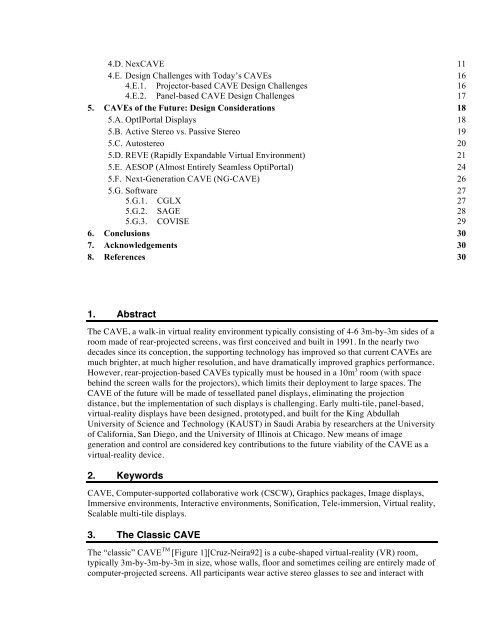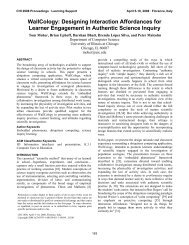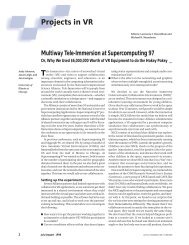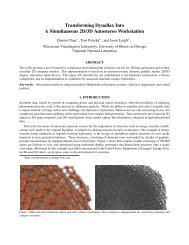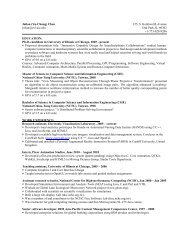The Future of the CAVE - Electronic Visualization Laboratory ...
The Future of the CAVE - Electronic Visualization Laboratory ...
The Future of the CAVE - Electronic Visualization Laboratory ...
You also want an ePaper? Increase the reach of your titles
YUMPU automatically turns print PDFs into web optimized ePapers that Google loves.
4.D.!Nex<strong>CAVE</strong> 11!<br />
4.E.!Design Challenges with Today’s <strong>CAVE</strong>s 16!<br />
4.E.1.! Projector-based <strong>CAVE</strong> Design Challenges 16!<br />
4.E.2.! Panel-based <strong>CAVE</strong> Design Challenges 17!<br />
5.! <strong>CAVE</strong>s <strong>of</strong> <strong>the</strong> <strong>Future</strong>: Design Considerations 18!<br />
5.A.!OptIPortal Displays 18!<br />
5.B.!Active Stereo vs. Passive Stereo 19!<br />
5.C.!Autostereo 20!<br />
5.D.!REVE (Rapidly Expandable Virtual Environment) 21!<br />
5.E.!AESOP (Almost Entirely Seamless OptiPortal) 24!<br />
5.F.! Next-Generation <strong>CAVE</strong> (NG-<strong>CAVE</strong>) 26!<br />
5.G.!S<strong>of</strong>tware 27!<br />
5.G.1.! CGLX 27!<br />
5.G.2.! SAGE 28!<br />
5.G.3.! COVISE 29!<br />
6.! Conclusions 30!<br />
7.! Acknowledgements 30!<br />
8.! References 30!<br />
1. Abstract<br />
<strong>The</strong> <strong>CAVE</strong>, a walk-in virtual reality environment typically consisting <strong>of</strong> 4-6 3m-by-3m sides <strong>of</strong> a<br />
room made <strong>of</strong> rear-projected screens, was first conceived and built in 1991. In <strong>the</strong> nearly two<br />
decades since its conception, <strong>the</strong> supporting technology has improved so that current <strong>CAVE</strong>s are<br />
much brighter, at much higher resolution, and have dramatically improved graphics performance.<br />
However, rear-projection-based <strong>CAVE</strong>s typically must be housed in a 10m 3 room (with space<br />
behind <strong>the</strong> screen walls for <strong>the</strong> projectors), which limits <strong>the</strong>ir deployment to large spaces. <strong>The</strong><br />
<strong>CAVE</strong> <strong>of</strong> <strong>the</strong> future will be made <strong>of</strong> tessellated panel displays, eliminating <strong>the</strong> projection<br />
distance, but <strong>the</strong> implementation <strong>of</strong> such displays is challenging. Early multi-tile, panel-based,<br />
virtual-reality displays have been designed, prototyped, and built for <strong>the</strong> King Abdullah<br />
University <strong>of</strong> Science and Technology (KAUST) in Saudi Arabia by researchers at <strong>the</strong> University<br />
<strong>of</strong> California, San Diego, and <strong>the</strong> University <strong>of</strong> Illinois at Chicago. New means <strong>of</strong> image<br />
generation and control are considered key contributions to <strong>the</strong> future viability <strong>of</strong> <strong>the</strong> <strong>CAVE</strong> as a<br />
virtual-reality device.<br />
2. Keywords<br />
<strong>CAVE</strong>, Computer-supported collaborative work (CSCW), Graphics packages, Image displays,<br />
Immersive environments, Interactive environments, Sonification, Tele-immersion, Virtual reality,<br />
Scalable multi-tile displays.<br />
3. <strong>The</strong> Classic <strong>CAVE</strong><br />
<strong>The</strong> “classic” <strong>CAVE</strong> TM [Figure 1][Cruz-Neira92] is a cube-shaped virtual-reality (VR) room,<br />
typically 3m-by-3m-by-3m in size, whose walls, floor and sometimes ceiling are entirely made <strong>of</strong><br />
computer-projected screens. All participants wear active stereo glasses to see and interact with


